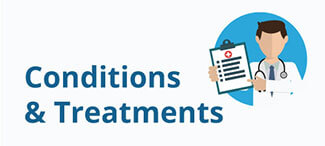WHAT IS POSTNATAL REHABILITATION?
Postnatal rehabilitation helps new mothers to recover effectively following pregnancy and delivery. Provided by therapists specialised in women’s health, postnatal rehabilitation enables mothers to return to enjoying a happy, healthy lifestyle with their family.
HOW CAN POSTNATAL REHABILITATION ASSIST MY RECOVERY?
Postnatal rehabilitation helps you to develop confidence and a better understanding of your pelvic area so that you can resume physical activities, including sexual intercourse and sports, quickly and safely. Trying to return to your usual physical activities too soon after delivering your baby can strain your muscles, negatively impacting your body and your quality of life. Typical symptoms include discomfort and heaviness in your abdomen and pelvic floor. These symptoms can be aggravated by inappropriate strengthening of your core muscles, which can lead to abdomen or back pain and pelvic organ prolapse.
During your postnatal rehabilitation, you will learn how to manage your body to prevent secondary complaints occurring a few weeks or months after returning to your usual daily activities.
This programme can also prevent complaints – such as spinal or pelvic pain – occurring months or years after delivery, and reduce the risk of urinary incontinence or prolapse as a result of sports activities or later in life during menopause.
WHAT KINDS OF CHANGES IN MY BODY WILL I HAVE TO COPE WITH?
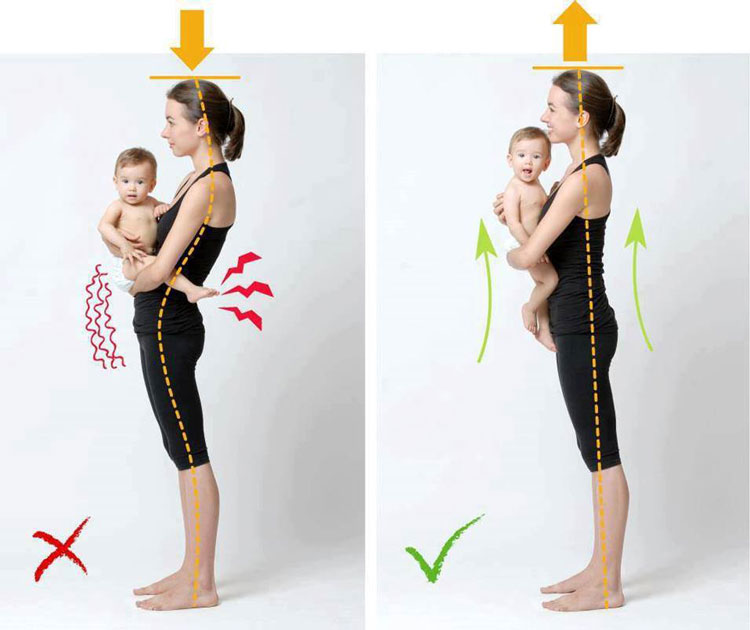
You won’t regain your former body immediately after giving birth. It’s important to be well informed about your postnatal period so that you can use these months to recover your body properly and give it the rest and care it needs.
Following delivery, you will see and feel many changes in your body. Your weight, your body shape, your mobility, your mood and energy level will all be different.
Part of the wonder of pregnancy is that your pelvis, abdomen and spine change quite rapidly to accommodate your growing baby and it’s common for new mothers to experience discomfort or pain in their back, pelvic floor or abdomen associated with these changes following delivery.
While it can be challenging to deal with the changes of the post-partum months alongside caring for your new baby, your family and preparing to return to work, your skilled, experienced rehabilitation team and your gynaecologist will support you, every step of the way.
WHAT DOES FV HOSPITAL’S POSTNATAL REHABILITATION PROGRAMME INVOLVE?
Your gynaecologist will work closely with our rehabilitation team. Physiotherapists and osteopaths will work together to tailor a programme to your needs, which will typically include pain management, adjustments of your pelvis and spine, massage, exercise, strengthening, stretching, adjustment of your posture, guidance for your daily activities, as well as help you prepare to return safely to sports activities.
Based on your condition, our dedicated team may recommend you a few sessions to safely achieve a full recovery of your body.
Please do not hesitate to ask about our postnatal rehabilitation programme.
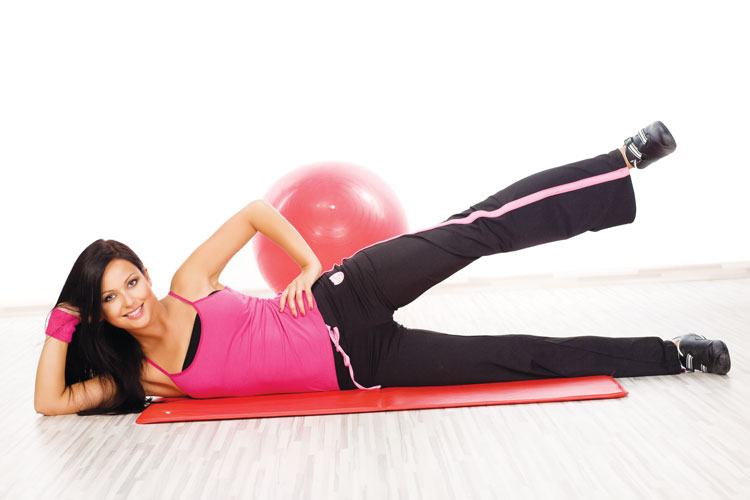
WHEN SHOULD I START REHABILITATION?
You can start our rehabilitation programme at any time after delivery, including during hospitalisation, with both an osteopath and physiotherapist.
For acute post-delivery symptoms or complicated delivery, your gynaecologist may refer you to commence rehabilitation immediately:
- Your osteopath will help to relieve pain in your back, neck or legs;
- Your physiotherapist can help in case of bladder or bowel control dysfunctions, such as incontinence or urgency.
Following an uncomplicated delivery, during your post-partum consultation, your gynaecologist may refer you for rehabilitation four to six weeks after delivery.
If you had a C-section, you may start eight weeks or more after delivery.
Your osteopath, through gentle manipulation, may realign your pelvis, spine and internal organs to ensure well-balanced pelvic function. Your osteopath may also help you to regulate and harmonise your nervous and hormonal system.
Your physiotherapist, through guidance and exercise, may help you to recover mobility and the strength of your pelvic floor muscles, rebuild your pelvic belt including your posture, core muscles and breathing patterns, to prepare to return safely to physical activities.
Even if you do not have specific symptoms, you can ask our rehabilitation team to assess your body functions to prepare for a safe return to physical activities.
Your osteopath will ensure that your pelvis, spine and internal organs return to their normal position and assist in optimising your energy level.
Your physiotherapist will ensure that your pelvic floor, abdominal wall, breathing functions are strong and that your posture is correct.
For women who expect a quick return to high level of sports activities, your gynaecologist may also recommend that you start early postnatal rehabilitation with a physiotherapist and osteopath specialised in women’s health and sports.
WHEN SHOULD I CONTACT THE REHABILITATION TEAM?
It’s never too late to contact the rehabilitation team after giving birth. They can help whenever you would like to return to physical activities and sexual intercourse confidently, or if you detect the following symptoms:
- Pelvis pain
- Backache or neck ache
- Sciatica
- Pain in multiple joints
- Extreme fatigue
- Hormonal or mood disturbance
- Menstruation pain.
In these cases, your osteopath can facilitate your recovery.
Furthermore, your physiotherapist will provide guidance and recommend exercises in case of:
- Incontinence or leaking when you are coughing, laughing or sneezing;
- Pelvic floor heaviness or weakness;
- Urinary or bowel disorders;
- Pain or dryness at intercourse;
- Scarring;
- Abdominal bulging due to strained abdominal muscles;
- Abdominal diastasis;
- Back pain or pelvic pain when standing, sitting or lying down;
- Regular, focused back pain or fatigue which appears when you are caring for your baby or at work;
- Poor muscle control or muscle weakness;
- Residual lipoedema.
WHAT CAN I DO JUST AFTER DELIVERY TO SPEED UP MY RECOVERY?
Following your delivery, the earlier you know how to move, to assess your recovery and to avoid pain, the better you will feel.
Always listen to your body, do not strain your body and never push into pain or discomfort. Coordinate rest time and short walks based on your baby’s sleeping and feeding habits.
At the maternity ward, do not hesitate to talk with your doctor, your midwife or your physiotherapist if you have any concerns. They can assist you at any time.
Early after your delivery, it is important to move around, to get out of bed and to walk to promote circulation and prevent blood clots.
You can start the following exercises immediately after your delivery:
IN BED
1. Practice ankle pumps: six repetitions, five to six times per day.
2. As you first begin to move in bed, try to bend your legs alternately, smoothly and slowly, one leg at a time. Repeat four movements, five to six times per day.
3. Try some gentle pelvic tilting to release soreness in your back. Repeat four movements, five to six times a day.
4. To relieve swelling or pain in the pelvic floor, or if you have haemorrhoid pain, apply an ice pack wrapped in a dampened cloth for 10 minutes every hour for 24 to 48 hours after delivery.
5. After applying the ice pack, in a lying position practice three to four pelvic floor “pulses” to assist circulation and healing. Gently draw your pelvic floor in and then release. Do not aim to hold your pelvic floor in or “stop pee”.
6. Draw your pelvic floor in as you need to cough or sneeze. If you have had a C-section, do the same while bracing your C-section wound area with your hands.
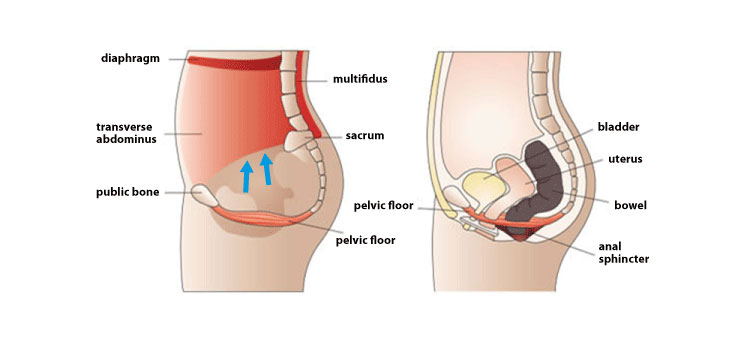
Pelvic floor “pulse”
GETTING OUT OF OR INTO BED
o Just after delivery, the first time you plan to get out of your bed, ask your midwife for assistance to prevent risk of a fall and to prevent damaging any wounds you may have.
o As your muscles are weak, to prevent pain in your spine and abdomen roll onto your side and use the sideline position taught to you during pregnancy by your physiotherapist.
Roll to the side to get out of bed. DO NOT try sitting straight up from lying on your back.
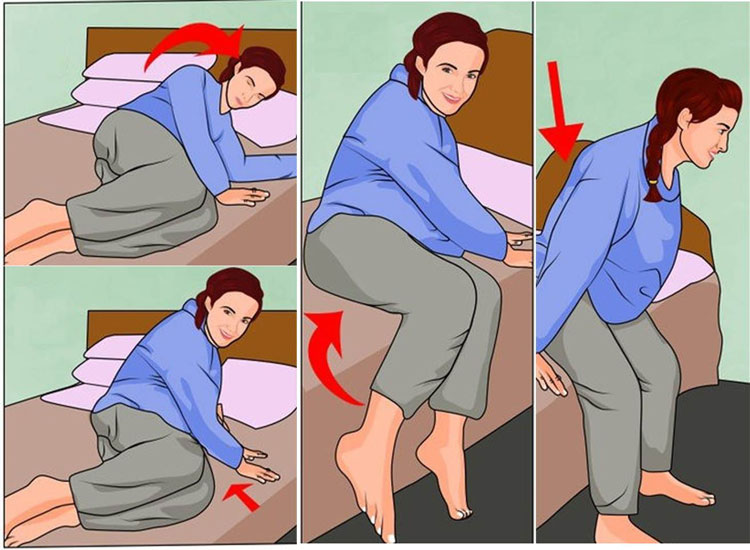
SITTING IN AN ARMCHAIR
- Sit in a comfortable armchair for short periods and while breastfeeding.
- Avoid sitting on the ring cushion, even though it reduces discomfort of your pelvic floor.
- Relax your body with calming music to release tension in your neck and shoulders. Take time to roll your shoulders forward and backwards a few times.
USING THE BATHROOM
- Sit comfortably on the toilet, keeping a curve in your low back as you lean forward from the hips.
- Lean through your forearms onto your thighs and allow your abdomen to relax forward.
- Breathe slowly without pushing on the pelvic floor. Do not hold your breath. Support C-section or perineum stitches as needed.
Solution 1: lift your heels off the floor and lean forward to relieve pressure on your pelvic floor.
Solution 2: use a footstool and maintain hip flexion to protect your pelvic floor.
HOW CAN I GET BACK INTO SHAPE AFTER DELIVERY?
You may be able to resume most of your home activities after being discharged from the Maternity Ward.
However, give yourself time to heal and recover. Plan to do very little in the first three weeks after delivery. Make gentle movements, plan minimal housework and avoid intensive heavy lifting activities or long periods of travel. Involve your partner in planning an ergonomic home environment for bathing and caring for your baby.
Following discharge, start short walks. Do not force your body – start slowly and increase the duration of your walks gradually as you feel more comfortable. It’s very important to continue your pelvic floor pulse exercises at this stage.
After one month, if you plan to attend postnatal fitness or yoga classes, contact your physiotherapist for a complete assessment prior to initiating any programme. Avoid swimming before your postnatal assessment as you may be at risk of infection.
As most physical activities increase abdominal and pelvic pressure, caution is recommended if:
- You experience abdominal or pelvic pain;
- Your abdomen is bulging. You should learn to control the bulging prior to strengthening exercises;
- You have poor control of your pelvic floor (leakage, air, heaviness);
- You hold your breath during activity.
In these cases, please consult your osteopath or your physiotherapist.
Following your rehabilitation programme, the best way to get back into shape is to combine an exercise programme with healthy eating. A progressive exercise regime that suits your body can guide you to an early and safe return to pre-pregnancy activities.
- However, to avoid being exhausted by a too busy programme, you should fit your exercise programme into your daily life and make exercising an enjoyable part of your day.
- You can engage in low impact activities such as walking, cycling or aqua-biking, swimming or jogging then gradually increase. You should also try more social activities during the first year instead of competitive or challenging sports.
- Resuming sports, running or any high impact activity immediately after delivery can put stress and strain on your healing tummy and pelvic floor muscles.
- If you enjoyed high impact competitive sports including jumping and lifting prior to your pregnancy, talk to your physiotherapist about how best to safely return to training.
Changes do not happen overnight. You will progress step by step to fully recover your body and your enjoyable, active lifestyle.
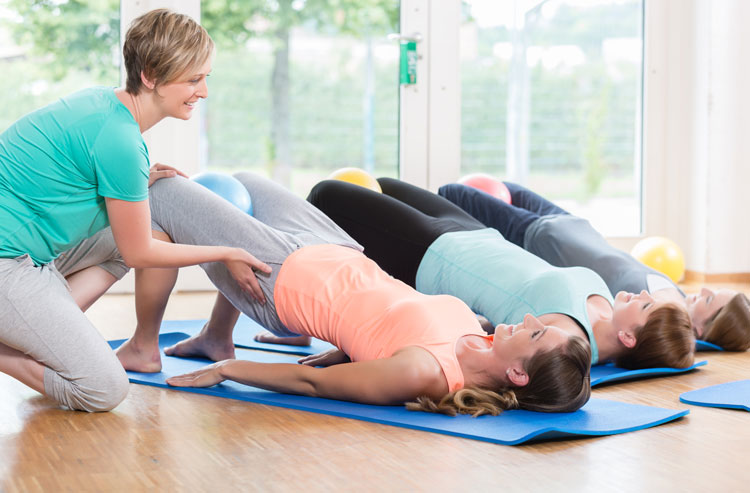
For information and appointment with Physiotherapist or Osteopath, please contact:
FV HOSPITAL – PHYSIOTHERAPY & REHABILITATION DEPARTMENT
Direct line: (028) 54 11 33 40 or (028) 54 11 33 33 ext: 1085 or 1485
Email: rehabilitation@fvhospital.com
For osteopathy, please contact:
FV CLINIC- BITEXCO TOWER
Direct line: (028) 62 90 61 67
Address: 3rd floor Bitexco Financial Tower, 2 Hai Trieu St., Ben Nghe Ward, Dist.1, HCMC.


